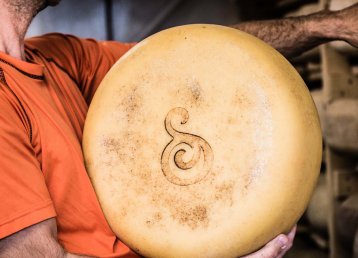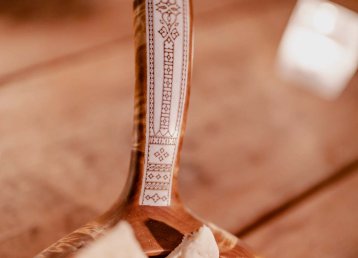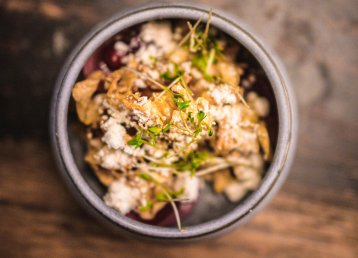You know there is about to be some serious cooking going on when the chef arrives armed with both a wheelbarrow and a spade. Tommi Tuominen from the restaurant Finnjävel in Helsinki stands next to the wheelbarrow and the ground in front of him is glowing. Somewhere in there, half a metre or so below the sandy surface, dinner is cooking. Lamb hock cooked the way the Finnish call rosvopaisti – ‘robbers’ oven’.
It takes time
A cooking pit has been a classic way of preparing food ever since we learnt to tame fire. Tommi Tuominen’s restaurant Finnjävel has had a Michelin star since 2021, and serves the best Finland has to offer. It is because of the event Stars du Nord Tommi Tuominen stands here by a cooking pit in Sweden. He has joined some of the best chefs in the Nordic countries to cook outside.
“When I was asked to participate in this food festival, I instantly wanted to make a cooking pit. Cook lamb as traditionally as possible.”
“It was actually the first time I did it in front of an audience. I’ve cooked in a pit before, but perhaps not as fine dining, so I’ve always dreamed of this.”
“The most important thing is to make sure what you’re cooking is the best quality. Then you put it in well-sealed packages that are very moist – they mustn’t dry out and start to burn. Everything has to be wet when you place it in the pit.”
“Also, you need a couple of nice beers while you wait. It takes time.”
Dinner in the midst of nature
Why does food taste better when you are eating out in nature? Maybe because all your senses are activated by what’s around. The sound and the smell and the feel. Maybe also because this is where food comes from. That’s the philosophy at Huuva Hideaway.
The little things
Life is about the little things. Of course you could be poetic like Per Lagerkvist: “We are the prism that refracts the light”. You know, thinking how you are an obvious part of the larger whole – space and all the rest. But lately these little things have become more and more meaningful to me. For example, I have realised that I will not be able to eat when I am dead. A truth that is hard to digest.
"Eating outside is essential to the people in the north"
The part of the world I travel around the most, the Arctic part of Sweden, is heaven for food lovers. All that excellent produce, and all the food traditions. When the Nordic Food Manifesto was written it felt like a tribute to the Arctic: a life where seasons dominate – fresh over a fire when possible, then smoked, dried, salted and pickled during other seasons. Eating outside is essential to the people in the north, and sometimes dinner is elevated to a new level by Nordic stars.
To catch a fish
Chef Johan Eriksson in Piteå might not have dreamt of eating outside, but of being outside. He had worked at Michelin-studded restaurants and been the kitchen manager of a restaurant that had just received its second star. But he was not looking to catch more stars: he wanted to catch a fish. Johan was dreaming of fly fishing as he moved between saucepans in the Swedish capital.
Thoughts wandering
We have a chat on a summer’s evening at his restaurant Centrum Krog, in Piteå. The night is pleasantly warm, and Johan says it is probably the kind of night when caddisflies hatch and the trout bites. I say that the dry-aged sirloin steak with XO sauce was tasty. Johan says he is heading to the mountains again soon, fishing. I say I am hoping to visit Jon-Oskar at restaurant Bryggargatan in Skellefteå before the end of the summer. Johan says he has tied a whole load of Woolly Buggers. I say I really liked their latest edition of Gin-Gin, but that I am now contemplating dessert. Johan says he longs for the taste of fresh fish, and then he asks:
“Have you ever had really fresh fish?”
The question surprises me, but I answer:
“Yes, I have. I assume you mean fish that kind of curls up when you fry it?”
Because that is the deal with fresh fish, if it has not been hung and you cook it in the middle of its rigor mortis, it curls up like that in the frying pan. Hemingway’s captain Gregorio Fuentes was well aware of this, so I have read about it if nothing else.
“Exactly! And if you eat it as sashimi it’s not soft, it’s almost crunchy when you chew it.”
Immediately I see his thoughts wandering back into the mountains, to trout biting in the warm summer night, and something crunchy to chew.
Star chef left for flyfishing in Swedish Lapland
At the age of 19, Johan Eriksson moved to Copenhagen to work as a chef at Noma. Ten years later, after he’d also worked at two-star Michelin restaurant Oaxen in Stockholm as head chef, he moved back home to his beloved Piteå in northern Sweden. Just to be able to go flyfishing in Swedish Lapland — when ever he wanted.
In the forest
But it is not just Tommi Tuominen who has his work cut out for him at Stars du Nord. Tommi’s cooking pit has been warm for more than four hours now. It is probably another couple of hours to go before he can serve is lamb.
A bit further away stands Nicolai Tram from Knystaforsen in Halland, a restaurant that was awarded a Michelin star in 2021. He is cooking reindeer over an open fire. This is food most of us are familiar with here in the northernmost part of Sweden. But when the barbecue is manned by someone like Nicolai, it is certainly exceptional. Nicolai serves all his food at Knystaforsen cooked over an open fire or a grill. It has become their signum.
“And here we are like bears”, he says and laughs.
“We just walk into the forest and collect everything we’re going to eat.”
The reindeer is carefully grilled, as far from well done you can get, but then there is the masterpiece itself: flambadou. In a special cast-iron tool that looks a bit like a candle snuffer, a cone-shaped cup, Nicolai packs plenty of elk fat that he melts over the open flame before pouring it over the reindeer fillets. The flavour is amazing. The elk fat gives the reindeer an additional taste dimension. The gaminess is heightened. The hunter in me makes a mental note to save the elk fat after this autumn’s hunt.
The hunter
Jon Oskar Arnason at Bryggargatan in Skellefteå moved here to cook, but it was probably the hunter in Jon Oskar who fell in love with Sweden. At his restaurant at Bryggarbacken in Skellefteå you might be served deer and elk and other game that Jon Oskar himself has helped provide. There is always something special about being served ptarmigan by someone telling you to chew carefully, as there may be shotgun pellets in the meat.
From an Arctic perspective, hunting, providing your own food, is completely natural. It is embedded in people’s DNA, from those who first inhabited these areas. Sometimes just because fur is warm. The approach ‘nose to tail’ was a given in these hunting cultures and nothing to do with writing beautiful cookbooks. Everything on the animal was used.
"From an Arctic perspective, hunting, providing your own food, is completely natural – it is embedded in people’s DNA"
Tonight, at Jon Oskar’s Bryggargatan, they serve grilled fallow deer after a starter of Kalix Löjrom vendace roe, finished off with both Arctic raspberry ice-cream and a little taster of Ógin Arctic raspberry. This perfectly frames a ten-course tasting menu, both the beginning and the end containing regional items with a protected designation of origin (PDO). Kalix Löjrom, the vendace roe, was the first Swedish delicacy to be granted status as a PDO, and the Arctic raspberry is the latest. Ógin, by the way, is Jon Oskar’s own, award-winning gin that you can find in many of the best Nordic bars.
The right temperature
Back to Stars du Nord. Next to Nicolai Tram is the Norwegian chef Kristian Vangen. He secured the first Michelin star for the restaurant Bare in Bergen in 2020. Since then, Kristian has moved on to other challenges and started the restaurant Gaptrast in the same town (to be opened in May 2024). He has started a quest for new stars, by cooking excellent food.
Here in the forest outside Storklinten he is cooking cod and chanterelles. It feels natural that a Norwegian chef takes on cod. However, good produce does not automatically mean a good dish. If there is one thing that can really fail on a barbecue, it is fish. Many amateur chefs have a tendency to kill the fish twice: the second time when they put it on the grill, burning it to a crisp.
“To me it’s important that the fish reaches a temperature of 38 degrees. Then it’s done, it flakes. In the oven it’s easy to keep track, but on the barbecue you have to watch it carefully and use the thermometer more often.”
“You can do it by grilling quickly and letting it rest until it reaches 38 degrees inside, or slowly and serve straight away.”
“The temperature is extremely important. Protein must have the right temperature, or the food experience won’t be the same.”
The whitefish in Kukkola
At Kukkolaforsen Turist & Konferens, by the mighty Torne River in Swedish Lapland, you can find what’s got to be some of the freshest whitefish of the entire planet – and they are pretty spectacular. Both the whitefish and the people are serving this arctic speciality.
Mooring boats
Simon Laiti runs Hemmagastronomi in Luleå, in Norra Hamn. Below his restaurant, by the pier, the company Junköfiskaren moor their boat in summer. They arrive with Baltic salmon that they catch in traps at the mouth of the river, but also whitefish and perch. Fresh fish for the inhabitants of Luleå, visitors, and Simon’s restaurant.
Back to basics
Hemmagastronomi is something of a tiny food universe with a restaurant, a bakery, a delicatessen, and a café. Simon always tries to keep it local. He grows his own vegetables, buys meat from local farmers, and then there is the company catching fish in the river, bringing it to the restaurant door.
“I come from the Torne Valley. To me, fish and other produce are essential. Whitefish and salmon in the river, perch in the lake, but also elk hunted in autumn.”
– Simon Laiti
“But still: the favourites of late summer and autumn are heavily-salted herrings grilled over an open fire. That, and fried vendace of course. I’m actually finding it difficult to decide what’s best.”
“If you boil potatoes over a fire and make a mash, frying the herring fillets on a griddle, you retain some of the fire flavour. It always adds to the food experience.”
“Sometimes the simple, the basic, really is the best. Everything tastes a bit more like summer if it’s been near a fire.”


































